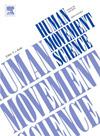假体踝关节刚度对单侧胫骨截肢患者适应不平坦地形的影响
IF 1.9
3区 心理学
Q4 NEUROSCIENCES
引用次数: 0
摘要
平坦的地形对单侧胫骨截肢患者的运动能力构成了重大挑战,影响了步态动力学和运动学。此外,假肢装置通常用于平地,尽管最佳装置特性(如刚度)可能因地形而异。研究问题:本研究评估假体刚度与行走面高度变化对步长特征和关节力学的相互作用。方法对9例单侧经胫骨截肢患者进行研究。参与者走在一个可修改的不平坦地形人行道上,以创造均匀的、低变异性和高变异性地形。在所有地形上,参与者使用三种不同刚度水平的踝关节-足假体:软、中、硬。我们使用人行道下方的两个地面力平台和运动捕捉相机系统记录步态动力学和运动学。结果骨骼变异性和假体刚度对多项生物力学指标均有影响,但两者之间不存在交互作用。地形影响台阶参数,如宽度、长度和可变性测量,而设备刚度影响平均台阶宽度和长度。地形和装置刚度对关节力矩和关节功没有显著影响。然而,僵硬影响了受影响和未受影响肢体之间踝关节和髋关节峰值力矩的差异。地形和刚度的影响存在于负踝关节和髋关节工作测量。平均而言,与平地相比,截肢者在不平坦地形上行走时关节动力学的变化相对较小。此外,设备刚度对步态结果的影响很小,以响应表面的变化。这些结果表明,在不平坦的地形上行走时,改变踝关节刚度可能不是减少关节负荷或改善步态对称性的有效策略。本文章由计算机程序翻译,如有差异,请以英文原文为准。
Effects of prosthetic ankle stiffness on adaptation to uneven terrain in individuals with unilateral transtibial amputation
Background
Uneven terrain poses significant locomotor challenges for individuals with unilateral transtibial amputation, affecting both gait kinetics and kinematics. Moreover, prosthetic devices are often prescribed for level-ground, although optimal device characteristics, such as stiffness, may vary depending on the terrain.
Research question
This study evaluated the interactions between prosthesis stiffness and walking surface height variability on step characteristics and joint mechanics.
Methods
Nine individuals with unilateral transtibial amputation participated in the study. Participants walked over a modifiable uneven terrain walkway to create even, low variability, and high variability terrain. On all terrains, participants used ankle-foot prostheses of three different stiffness levels: soft, medium, or stiff. We recorded gait kinetics and kinematics using two in-ground force platforms beneath the walkway and a motion-capture camera system.
Results
Terrain variability and prosthesis stiffness affected multiple biomechanical measures, but did not demonstrate any interaction effects between each other. Terrain influenced step parameters such as width, length, and variability measures, while device stiffness affected mean step width and length. Terrain and device stiffness did not significantly affect joint moments or positive joint work. However, stiffness affected the difference in peak ankle and hip moments between the affected and unaffected limbs. Terrain and stiffness effects were present in negative ankle and hip work measures.
Significance
On average, individuals with amputation exhibited relatively small changes in joint dynamics when walking on uneven terrain compared to level ground. Additionally, device stiffness had only minor effects on gait outcomes in response to changes in surface. These results suggest that varying ankle stiffness may not be an effective strategy for reducing joint loading or improving gait symmetry during uneven terrain walking.
求助全文
通过发布文献求助,成功后即可免费获取论文全文。
去求助
来源期刊

Human Movement Science
医学-神经科学
CiteScore
3.80
自引率
4.80%
发文量
89
审稿时长
42 days
期刊介绍:
Human Movement Science provides a medium for publishing disciplinary and multidisciplinary studies on human movement. It brings together psychological, biomechanical and neurophysiological research on the control, organization and learning of human movement, including the perceptual support of movement. The overarching goal of the journal is to publish articles that help advance theoretical understanding of the control and organization of human movement, as well as changes therein as a function of development, learning and rehabilitation. The nature of the research reported may vary from fundamental theoretical or empirical studies to more applied studies in the fields of, for example, sport, dance and rehabilitation with the proviso that all studies have a distinct theoretical bearing. Also, reviews and meta-studies advancing the understanding of human movement are welcome.
These aims and scope imply that purely descriptive studies are not acceptable, while methodological articles are only acceptable if the methodology in question opens up new vistas in understanding the control and organization of human movement. The same holds for articles on exercise physiology, which in general are not supported, unless they speak to the control and organization of human movement. In general, it is required that the theoretical message of articles published in Human Movement Science is, to a certain extent, innovative and not dismissible as just "more of the same."
 求助内容:
求助内容: 应助结果提醒方式:
应助结果提醒方式:


